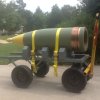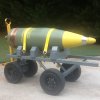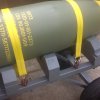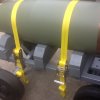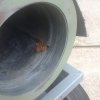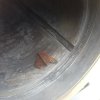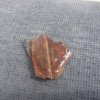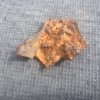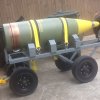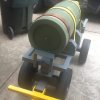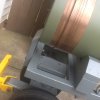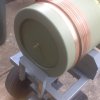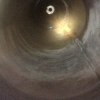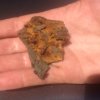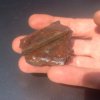British Ordnance Collectors Network
You are using an out of date browser. It may not display this or other websites correctly.
You should upgrade or use an alternative browser.
You should upgrade or use an alternative browser.
My Naval 16"/50 handling cart.
- Thread starter 917601
- Start date
I like it higher up,displays well, the engraving on the driving band can be read.... but still preoccupied with its high CG. I will at the very least widen the front axle, I can get 34", two inches wider than the rear should not be to noticeable and add a bit more degree of safety.It looks pretty cool on the cart. It looks like its ready to be shoved into a gun.
At a later date maybe even drop the 4x4's, lowering it another 3 1/2 inches...always not enough time.
thekees
Well-Known Member
Like it at so far, curious how you (winch?) this on your car trailer, even more the first officer that "has some questions" when on the road. The heaviest shell i've transported so far are two 11 inch shells at the same time on the trialer, totally half your weight. If on a search for a German 38 cm shell, and that's the point i have to learn from your experiences. Thanks for sharing!
glevum
Well-Known Member
The shel looks very nice on the trolley.
How are you going to secure it on the car trailer? Towing could get very interesting if it starts moving around on the trailer.
When i collected my 15" shell it was on a heavy pallet. I used lots of big cargo straps to secure the shell to the pallet and then put it in the back of our landrover. I then packed the space between the pallet and the sides of the load bed with large solid wooden packers. It travelled very well like that.
The landy has a payload of 1400kg, so it was well within weight and drove very well. Acceleration was a bit slower than normal though.
We loaded it with a forklift and unloaded it with a telehandler. So no manual handling
How are you going to secure it on the car trailer? Towing could get very interesting if it starts moving around on the trailer.
When i collected my 15" shell it was on a heavy pallet. I used lots of big cargo straps to secure the shell to the pallet and then put it in the back of our landrover. I then packed the space between the pallet and the sides of the load bed with large solid wooden packers. It travelled very well like that.
The landy has a payload of 1400kg, so it was well within weight and drove very well. Acceleration was a bit slower than normal though.
We loaded it with a forklift and unloaded it with a telehandler. So no manual handling
Coming along. Placed two 3300 lb working load ratcheting straps hopefully correctly to hold it in place while trailering. The 2400 lb rated eye nuts are secured with 1/2" Grade 8 bolts. Drilling was a chore, step drilled. Chose not to weld anchor points as I would have to remove the projo to do this, thus drilling. I plan to use one 5,500 lb working load chain and binder and chocks to anchor it onto the trailer while trailering. Cautions and concerns welcomed.
Attachments
Last edited:
What else to do, projects keep me going ( like most of us here). I like wheeling one ton around, like the old days. When I get tired, I sit down and have a beer. More pics.I know you put a lot of work and effort into this project, and it shows. But, you coulda got one of these:
View attachment 146074
Maybe there's one out there in the surplus market. AND, you could use it around the house when you aren't moving big bullets.
Attachments
Slick kids, but they used to have some of those bomb-loading jammers at Barsto Truck Parts. Sadly it is defunct, and that was 25 years ago.
Now the transport story: A company named Bucyrus-Erie had a division in Pocatello Idaho that had the contract for reconditioning the 16 inch barrels for the various Battleships. The rebuilt barrels would be shipped to the edge of the Atomic Energy Site that is West of Idaho Falls to be proof tested, where they had a 16 inch gun. US-Subs has actually worked EOD-QC at that firing range. They would fire solid steel proof projectiles to test the barrels, and the projectiles would leave huge gouges in the terrain downrange of the gun. Before 911, security was pretty lax in that area, and enterprising scroungers would drive into the impact area to recover the projectiles for their own display use. Since the projectiles weighed around 3,000 lb., mistakes needed to be avoided during handling and transport. One less than careful guy dug a ramp into the ground so his pickup bed was down at projectile level on the ground. He then winched the big bullet into his pickup bed and headed for home. The story isn't clear as to if he chocked the projo, or if the chocks came loose, but when he drove around a corner, the projo rolled to one side of the truck bed, and the tire blew on that side. Gravity continued its part, and the moving projectile rolled the whole truck over.
So, preventing unexpected degrees of freedom during your trailering would be advised.
Now the transport story: A company named Bucyrus-Erie had a division in Pocatello Idaho that had the contract for reconditioning the 16 inch barrels for the various Battleships. The rebuilt barrels would be shipped to the edge of the Atomic Energy Site that is West of Idaho Falls to be proof tested, where they had a 16 inch gun. US-Subs has actually worked EOD-QC at that firing range. They would fire solid steel proof projectiles to test the barrels, and the projectiles would leave huge gouges in the terrain downrange of the gun. Before 911, security was pretty lax in that area, and enterprising scroungers would drive into the impact area to recover the projectiles for their own display use. Since the projectiles weighed around 3,000 lb., mistakes needed to be avoided during handling and transport. One less than careful guy dug a ramp into the ground so his pickup bed was down at projectile level on the ground. He then winched the big bullet into his pickup bed and headed for home. The story isn't clear as to if he chocked the projo, or if the chocks came loose, but when he drove around a corner, the projo rolled to one side of the truck bed, and the tire blew on that side. Gravity continued its part, and the moving projectile rolled the whole truck over.
So, preventing unexpected degrees of freedom during your trailering would be advised.
I was cleaning out the interior of the shell and found a piece of the explosive filler stuck tight near the nose at the end of the channel. I removed it by banging it free with a long rod. Question is, how did it get there? It appears to be melted, and is rusted. It looks like an exploded piece of shrapnel, but that does not make sense. Maybe the shell was cooked to disarm it and this is a piece left over? I used Ospho to remove the light rust on the interior and need to paint the inside. Was it ever painted or just used a chemically converted coating? If so, what color should I paint the inside ( yeah, I known I have a lot of time on my hands).
Attachments
Last edited:
I also added a welded steel square tubing " fixture" to keep the projo from migrating aft towards the base during traveling. Maybe not needed, but it now appears to be firmly "locked" in place. Now, down to stencilling ID and informational material....I am well satisfied with the finished product.
Attachments
I doubt if your projectile was ever loaded. The source where it came from has around 300, and they have never been painted service colors on the outside, only primer coated. The filler would have been Explosive D, which isn't cast by melting. It is an Ammonia based explosive made to be insensitive to high-impact such as slamming into a wall of homogeneous steel armor. Therefore no heat would have been used to remove it. They would most likely use a water jet these days.
Now you need to add fenders to prevent the wheels from splattering your bullet, and a color-coordinated tarp to keep the weather off of it during transport, along with bugs, and other airborne contaminants.
Now you need to add fenders to prevent the wheels from splattering your bullet, and a color-coordinated tarp to keep the weather off of it during transport, along with bugs, and other airborne contaminants.
If never loaded, how to explain the piece pictured? It was very, very firmly rusted in place. I had bought it from a man in Iowa, (not Marshall), he even delivered it and said he acquired it (a few of them, a couple years ago) and a whole truckload of Ordnance from a deceased Crane supervisors estate. The son had no interest in the barn full of Ordnace his father had acquired, or so the story goes. Any theories how the channeled piece would have been rusted into place ( about 29 inches down the channel)? I put the piece back into the channel where I had to bang it out, the channel fwd of it is also rusted, see pic- where the bright spot is. Puzzled.
Attachments
Last edited:
Now that we have photos that show the interior of the 16" shell, It appears to me that it may be an antipersonnel shell rather than an HC shell. The MK19 antipersonnel shell was a base-ejection cargo shell that contained 400 M43A1 grenades. That shell had the channels on the interior and a stop for the pusher plate at the nose end of the channels. Both of these features are shown in the current photos and would serve no purpose in a straight high explosive shell. Another feature that is different in the two types of 16" shells is the base plug. The base plug of the cargo shell is pressed in and fitted with shear pins to allow base ejection of the grenades. The base plug of the high explosive shell is threaded. Hazord, does this seem reasonable as I believe you know a lot more about large caliber ordnance than I do?
Also, the rusty piece of "mystery" metal looks a lot to me like torch cutting slag. Was this shell once torch cut at the nose? All the 16" shells I have seen that came off of Crane decades ago all had demil torch cuts on the nose or at the base below the rotating band.
Also, the rusty piece of "mystery" metal looks a lot to me like torch cutting slag. Was this shell once torch cut at the nose? All the 16" shells I have seen that came off of Crane decades ago all had demil torch cuts on the nose or at the base below the rotating band.
I'm going to agree with most of what you have said. The groove on the inside and the minimal thread would lead one to believe that the projectile was indeed manufactured to carry a cargo load of grenades or anything else. The dovetail groove/grooves are for aluminum pieces that prevent the cargo from rotating inside the projectile body. There has been talk that large projectiles like this and the 8 inch M509 could be used to carry a nuclear cargo, by simply removing the base and cargo, and substituting what was needed. Empty bodies could be kept in stock for this application also.
These projectiles were most likely moved with a magnet. I believe the piece of metal from inside is just a piece of scrap metal that was run through a chipper and found its way inside the projo body in the scrap pile. Rainwater got inside the body and rusted it to the inner surface.
These projectiles were most likely moved with a magnet. I believe the piece of metal from inside is just a piece of scrap metal that was run through a chipper and found its way inside the projo body in the scrap pile. Rainwater got inside the body and rusted it to the inner surface.
Good information. Thank you. The interior has two channels, I assumed the explosive was " pre packaged", encased and slid into the interior using the channels as guides. The base is threaded, but thin threading. I will get more picks and measurements when able. I assume the numbers on the driving band would nail the specific type down exactly. I have no idea what these numbers mean. Engraving on the driving band : "ADL 53711-6573334-000 16 IN. CRA91H001-001". The nose and base had been torch cut ( rewelded).
CRA91H is most likely Crane 1991 August (H is the 8th month) They specify 2 grooves in projectiles 8 inches and above. 8 inch 509's have 2 grooves. 155mm M483's have 1 groove.
Since your projectile is a submunition model, you will need to repaint it to have yellow diamonds around the ogive, and put a proper Army M565E1 fuze and proper fuze adaptor on it. These photos from above show the proper profile of the Army Fuze on the proper adaptor.
Since your projectile is a submunition model, you will need to repaint it to have yellow diamonds around the ogive, and put a proper Army M565E1 fuze and proper fuze adaptor on it. These photos from above show the proper profile of the Army Fuze on the proper adaptor.
Attachments
Last edited:







